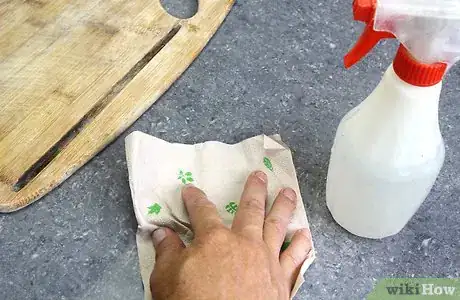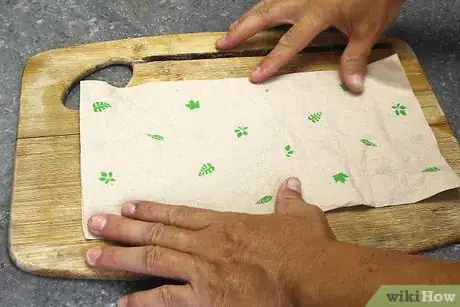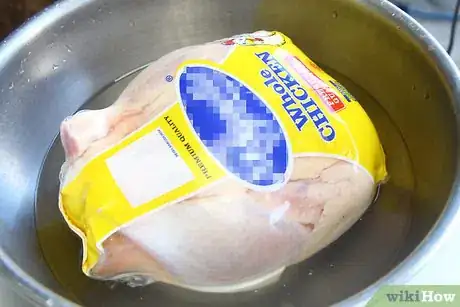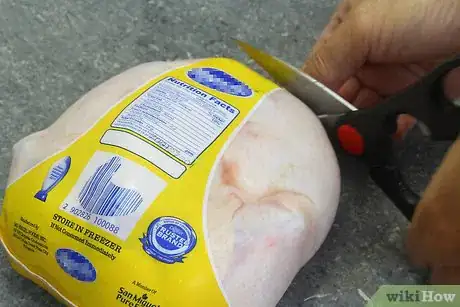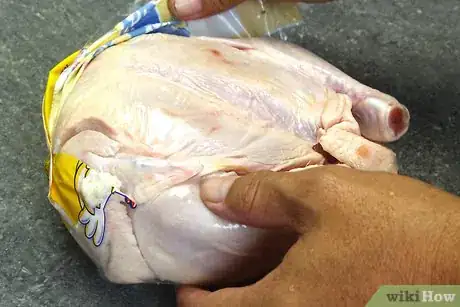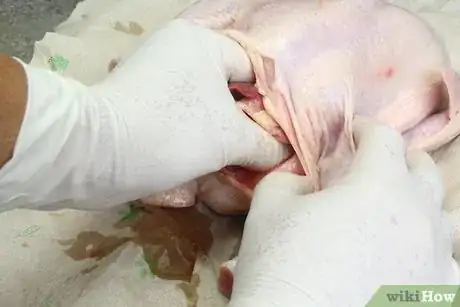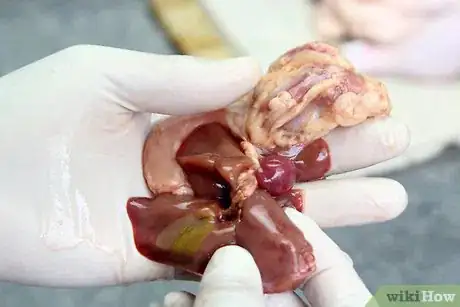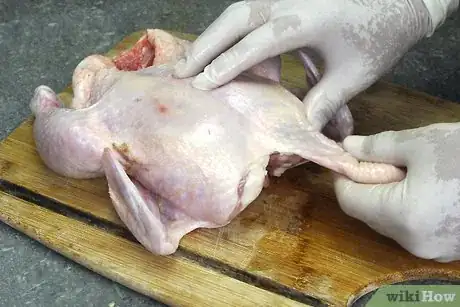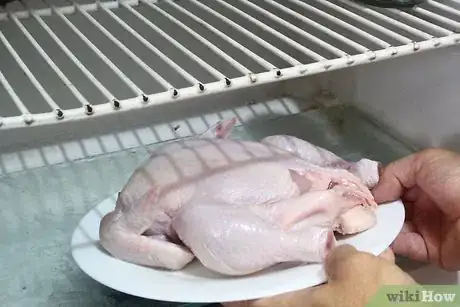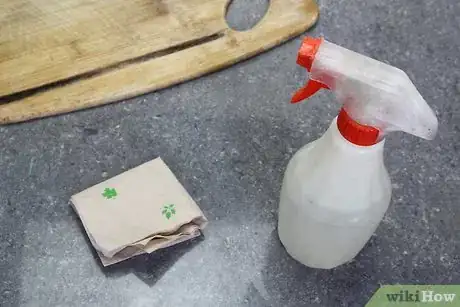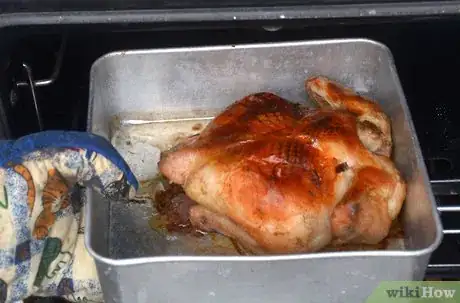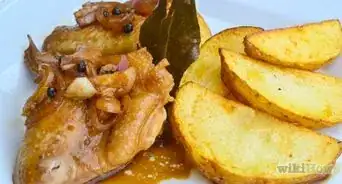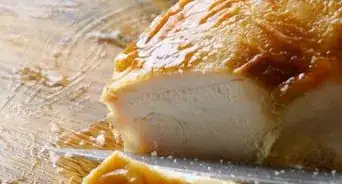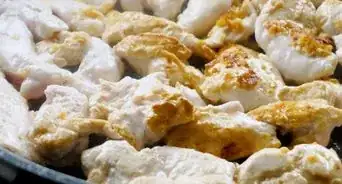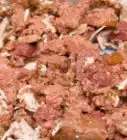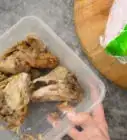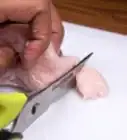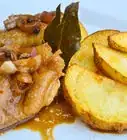This article was co-authored by JoAnna Minneci. JoAnna Minneci is a Professional Chef based in the Nashville, Tennessee area. With more than 18 years of experience, Chef JoAnna specializes in teaching others how to cook through private cooking lessons, team-building events, and wellness and nutrition classes. She has also appeared in numerous television shows on networks such as Bravo and Food Network. Chef JoAnna received Culinary Arts training from the Art Institute of California at Los Angeles. She is also certified in sanitation, nutrition, kitchen management, and cost control.
There are 14 references cited in this article, which can be found at the bottom of the page.
This article has been viewed 92,813 times.
These days, most people are probably used to getting their chicken pre-butchered and neatly packaged in plastic wrap. But knowing how to prepare a whole chicken from scratch is an essential skill that any culinary enthusiast should possess, and preparation always begins with a thorough cleaning. The primary purpose of cleaning chicken is to trim excess fat and tissue and ensure that the meat comes out with just the right flavor and consistency. It’s also important to keep your hands, utensils, and all work surfaces clean to prevent the spread of bacteria.
Things You Should Know
- Thaw the chicken in the fridge overnight before cleaning it. If you're in a rush, thaw it in a bowl of cold water, replacing the water every 30 minutes.
- Cut any twine or wire holding the chicken together.
- Remove the giblets and kidneys from the cavity near the tail section of the bird.
- Trim the excess fat around the neck and tail with a knife.
Steps
Working with a Whole Chicken
-
1Keep your work area clean. Raw chicken often contains a host of bacteria that can be harmful if ingested.[1] For this reason, it’s a good idea to clear your work area of other exposed ingredients, as well as personal items like your cell phone, in order to prevent cross-contamination.[2]
- Avoid putting your hands in your mouth or touching nearby objects after handling raw chicken. If you're not careful, you could end up spreading germs all over your home.[3]
- Don't forget to wipe down any surfaces that you may come into contact with during prep, such as the faucet or drawer pulls.
-
2Cover your work surface with a layer of paper towels. The paper towels will act as a barrier to keep the juices from the chicken from getting all over your countertops or cutting board.[4]
- You can also use paper towels to gently pat your chicken dry after thawing it.
Advertisement -
3Allow frozen chicken to thaw. Poultry that’s been stored in the freezer will first need to be thawed to bring it up to room temperature.[5] The best way to do this is to simply stick it in the refrigerator and leave it to sit overnight. If time is of the essence, dunk the (wrapped) chicken into a cold water bath, draining and running fresh water every half hour.[6]
- It will take about 24 hours for every 5 pounds (2.3 kg) to thaw in the refrigerator, and about 30 minutes per 1 pound (0.45 kg) in a water bath. Make sure you plan accordingly so you can have dinner on the table on time.
- Always cook chicken immediately after you thaw it.
-
4Remove the chicken from its packaging. Most of the time, whole chickens are sold in sealed plastic bags. Snip the end off the bag with a pair of scissors, then reach in, grab the chicken by the drumsticks, and lift it out. Be sure to hold the bag upright to prevent the collected juices from leaking out all over the place.[7]
- Discard the chicken packaging right away so that bacteria present don’t have a chance to spread to your surroundings.
-
5Cut away any materials holding the chicken together. Butchers sometimes use twine, wire, or rubber bands to secure poultry in a more compact shape. If the chicken you’re preparing comes trussed, clip the binding with a pair of scissors, being careful not to damage the skin or meat. Make sure you have direct access to the cavity near the tail end.
- Like the rest of the packaging, these materials should go straight into the trash.
- Binding is intended to make whole chicken easier to package and roast, but it will just get in your way during the cooking process, and can even interfere with the meat’s ability to heat through evenly.[8]
Trimming the Chicken
-
1Pull out the giblets. Whole chickens sometimes come with their giblets, or internal organs, packaged and stuffed inside. Reach into the cavity near the tail section and feel for a large plastic or butcher paper packet. Remove this packet and set it aside. Give plastic packets a quick rinse before placing them on your work surface.[9]
- You can use the giblets to prepare stocks, broths, and gravies. Many chefs also enjoy frying them up and serving them on their own for their rich nutritional content.[10]
- If you’re not interested in saving the giblets, make sure you discard them along with the rest of the packaging.
-
2Remove the kidneys. Now that the giblets are out of the way, examine the inside of the cavity for the kidneys. They’ll look like small, round, dark red or brown protrusions on the backside of the bird just above the tail. To extract them, take hold of them where they connect to the tissue and give them a sharp tug. They should come right out with little resistance.[11]
- The kidneys are sometimes left intact or passed over when chickens are butchered. This is more common when buying poultry from a farm or organic food market rather than a supermarket chain.
-
3Trim the excess fat and gristle. Fat deposits can most often be found around the neck and tail area. When you come across unwanted tissue, pull it away from the meat with one hand and use a sharp knife to shear it off carefully. Dispose of the fat, or hold onto it and find another use for it.[12]
- Chicken fat is useful for greasing fry pans and casserole dishes prior to cooking or as a way of imparting some extra flavor to soups, stocks, or stir fries.
- If you want to save chicken fat for cooking, you'll first need to render it. Once it's been rendered, the fat will be easier to store and can last up to 4 weeks in the refrigerator.[13]
Getting Your Chicken Ready for the Oven
-
1Refrigerate the chicken uncovered for 1 hour. Place the chicken into a roasting pan and slide it onto the bottom shelf. That way, any juices that happen to escape won’t come into contact with other food. A short rest period will give the chicken a chance to dry thoroughly after thawing, resulting in more evenly-cooked meat with a crispier finish.[14]
- To make the best use of your time, begin preheating the oven 15-20 minutes before the chicken comes out.
- If you're short on time, you can just dry the chicken thoroughly with paper towels and get right to cooking.
- Never leave raw chicken sitting at room temperature.
-
2Sanitize your work area. As soon as you’re done handling the chicken, wash all used tools and materials with antibacterial soap and hot water. Next, gather up the paper towels and put them in the trash. Finally, spray the countertop or cutting board with a strong disinfecting solution, let it to sit for a few minutes, and wipe it down.[15]
- For the sake of you and your loved ones’ health, be vigilant about cleaning any other areas where germs may be lurking, like the area around the sink or trash can.
- Remove the trash containing the packaging and discarded bits to an outside receptacle. Otherwise, it can quickly begin to stink up your kitchen.
-
3Cook the chicken as desired. Now that it’s clean, it’s ready to be seasoned and roasted. For maximum flavor, stuff the cavity with flavorful aromatics like lemon wedges, a few sprigs of rosemary, or whole garlic cloves. Injecting your favorite brine or marinade under the skin will help make the chicken more tender and juicy, and can be a great way to jazz up a boring bird.[16]
Expert Q&A
-
QuestionShould I wash my chicken?
 JoAnna MinneciJoAnna Minneci is a Professional Chef based in the Nashville, Tennessee area. With more than 18 years of experience, Chef JoAnna specializes in teaching others how to cook through private cooking lessons, team-building events, and wellness and nutrition classes. She has also appeared in numerous television shows on networks such as Bravo and Food Network. Chef JoAnna received Culinary Arts training from the Art Institute of California at Los Angeles. She is also certified in sanitation, nutrition, kitchen management, and cost control.
JoAnna MinneciJoAnna Minneci is a Professional Chef based in the Nashville, Tennessee area. With more than 18 years of experience, Chef JoAnna specializes in teaching others how to cook through private cooking lessons, team-building events, and wellness and nutrition classes. She has also appeared in numerous television shows on networks such as Bravo and Food Network. Chef JoAnna received Culinary Arts training from the Art Institute of California at Los Angeles. She is also certified in sanitation, nutrition, kitchen management, and cost control.
Professional Chef You should never wash a chicken, since all it will do is spread bacteria all around the kitchen sink. And now, you not only have the risk of having your kitchen potentially contaminated with salmonella, but you still have to cook the chicken anyway.
You should never wash a chicken, since all it will do is spread bacteria all around the kitchen sink. And now, you not only have the risk of having your kitchen potentially contaminated with salmonella, but you still have to cook the chicken anyway. -
QuestionHow do I make sure my chicken isn't dry?
 JoAnna MinneciJoAnna Minneci is a Professional Chef based in the Nashville, Tennessee area. With more than 18 years of experience, Chef JoAnna specializes in teaching others how to cook through private cooking lessons, team-building events, and wellness and nutrition classes. She has also appeared in numerous television shows on networks such as Bravo and Food Network. Chef JoAnna received Culinary Arts training from the Art Institute of California at Los Angeles. She is also certified in sanitation, nutrition, kitchen management, and cost control.
JoAnna MinneciJoAnna Minneci is a Professional Chef based in the Nashville, Tennessee area. With more than 18 years of experience, Chef JoAnna specializes in teaching others how to cook through private cooking lessons, team-building events, and wellness and nutrition classes. She has also appeared in numerous television shows on networks such as Bravo and Food Network. Chef JoAnna received Culinary Arts training from the Art Institute of California at Los Angeles. She is also certified in sanitation, nutrition, kitchen management, and cost control.
Professional Chef Take it out of the fridge and let it rest for about 20 minutes so that it can come up to room temperature. The slower the thermal shock, the less likely the chicken is going to dry out as you cook it. Always use a thermometer when you're cooking so that you have less of a chance to overcook it.
Take it out of the fridge and let it rest for about 20 minutes so that it can come up to room temperature. The slower the thermal shock, the less likely the chicken is going to dry out as you cook it. Always use a thermometer when you're cooking so that you have less of a chance to overcook it.
Warnings
- It’s not a good idea to attempt to thaw a frozen chicken in the microwave. This heats the meat inconsistently, which can cause it to become mushy or rubbery when cooked.⧼thumbs_response⧽
- Consuming raw or undercooked chicken can make you extremely ill.⧼thumbs_response⧽
- Don’t rinse the chicken before preparing it. It’s not an effective way to remove bacteria or other contaminants, and it can actually increase your chances of getting food poisoning by spreading bacteria onto your hands and clothing and around your work area.[19] [20]⧼thumbs_response⧽
Things You'll Need
- Cutting board (optional)
- Shallow roasting dish
- Sharp knife
- Scissors
- Paper towels
- Trash bags
- Antibacterial soap
- Disinfecting spray
- Separate storage containers (for saving fat and organs)
References
- ↑ JoAnna Minneci. Professional Chef. Expert Interview. 23 November 2021.
- ↑ http://www.businessinsider.com/mistakes-to-avoid-when-handling-raw-chicken-2017-8
- ↑ https://www.cdc.gov/features/salmonellachicken/index.html
- ↑ http://www.noreciperequired.com/technique/how-clean-chicken
- ↑ JoAnna Minneci. Professional Chef. Expert Interview. 23 November 2021.
- ↑ https://www.myfearlesskitchen.com/how-to-thaw-a-whole-chicken/
- ↑ http://www.noreciperequired.com/technique/how-clean-chicken
- ↑ http://www.mensjournal.com/food-drink/recipes/hot-to-wash-and-cut-up-a-whole-chicken-20150224
- ↑ http://www.thekitchn.com/what-are-giblets-65220
- ↑ https://paleoleap.com/complete-beginners-guide-giblets/
- ↑ http://www.recipetips.com/kitchen-tips/t--1090/cleaning-chicken.asp
- ↑ http://www.recipetips.com/kitchen-tips/t--1090/cleaning-chicken.asp
- ↑ http://www.pennilessparenting.com/2010/10/rendering-chicken-fat.html
- ↑ http://www.noreciperequired.com/technique/how-clean-chicken
- ↑ http://www.bhg.com/recipes/how-to/food-storage-safety/how-to-eliminate-bacteria-in-the-kitchen/
- ↑ https://www.thekitchn.com/how-to-roast-the-perfect-chicken-cooking-lessons-from-the-kitchn-108002
- ↑ https://www.foodsafety.gov/keep/charts/mintemp.html
- ↑ JoAnna Minneci. Professional Chef. Expert Interview. 23 November 2021.
- ↑ https://www.nhs.uk/live-well/eat-well/never-wash-raw-chicken/
- ↑ JoAnna Minneci. Professional Chef. Expert Interview. 23 November 2021.
About This Article
To clean a chicken, start by pulling out the giblets and kidneys. Once the inner cavity is clean, trim the excess fat and gristle around the neck and tail area with a sharp knife. Then, rinse the chicken inside and out with cold water. Make sure the water is cold since using warm water can raise the temperature of the meat and accelerate bacterial growth, causing it to spoil. To learn how to get your chicken ready for the oven, keep reading!
